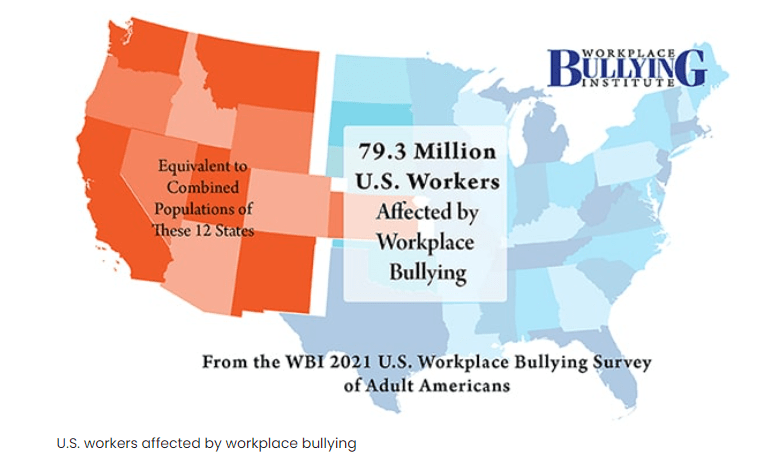
Bullying makes everyone recall hurtful memories. Such is the nature of this harmful activity that affects all the parties involved. Acts of physical, verbal, or psychological violence carried out against another person, to make them feel inferior is known as workplace bullying. This act is known to make employees feel out of place and uncomfortable in their work environment. Harsh remarks against a person, intimidating colleagues through violent actions, or making others in the office feel undervalued by constant criticism.
Bullying in offices can occur by both superior and inferior employees in the hierarchy may play the role of a bully by making office space an unbearable place for colleagues. This decreases employees’ work efficiency and makes them lose their trust in the organization.
Different research and studies have been carried out on workplace bullying. Based on HBR.org statistics reports, researchers have estimated that out of the total American population, 48.6 million Americans are made victims of workplace bullying. In India, the numbers are found to be comparatively higher with estimated values that have been known to be as high as 46%, and on certain occasions 55%. Regardless of the severity of the situation and the increasing rates of bullying, there is still little action to properly address this social issue.
Different Forms of Workplace Bullying
Workplace bullying can exist in different forms. It can happen to volunteers, interns, apprentices, and casual or even permanent employees. In several certain cases, they severely affect the employees to the point where they file a case against the organization with attorneys and are given the title of criminal violations. Bullying takes the following forms:

Other forms of bullying may also exist. Any action that can make an employee feel low or mentally drained can be considered a source of bullying. By adopting certain tested practices, a safe and healthy work environment can be made where all employees can be productive and can achieve their work goals on time.
How Does Bullying Affect Work?
A normal work environment is one in which all the employees treat each other like family, work together in harmony, and are willing to go the extra mile for their organization’s success, which is often referred to as Organizational Citizenship Behavior (OCB). According to research conducted by workplacebyllying.org, in 2021, it has been observed that 79.3 Million Americans feel troubled at their workplace because of bullying. Below is the graphical representation of surveying 12 US states.
A dull and demotivating work environment makes the employees feel mistreated when bullying in the workplace increases. This leads to a decrease in their morale and job efficiency.
It is not beneficial for those organizations that aim to continue functioning in the long term and want to actively meet their long-term goals. Employees can be affected by workplace bullying in various ways:
How to Cope with Workplace Bullying
According to the latest data, it has been found that one out of four workers in the United Kingdom has reported being bullied at work. 37% of workers in Australia have reported that they have been cursed or yelled at while they were working. When it comes to its effect on businesses, workplace bullying costs Australian businesses more than $6 billion annually.
As human beings, it is an organization’s responsibility to make others feel welcome and comfortable. Instead of being a part of such negative activities, the organization can take small steps to create a stable workplace. Some commonly used methods that an employee can adopt include:
If an employee feels uncomfortable while confronting their bully, they can go to their manager or supervisor and let him/her know about the whole situation. If the manager is the person who is constantly bullying you or you feel uncomfortable while talking about this issue with him/her, it is always a good idea to go and have a chat with the representatives in the human resource department. In most cases, the human resource department deals with such issues by moving forward with mediation. However, if the circumstances are severe, then the department also has the authority to punish or fire the employee.

2. Check and Update the Workplace Guidelines
Often newly hired employees are given workplace guidelines that help them navigate around the office. Employees can check these guidelines to find more information on how to deal with the situation, whom they should go to, and which proper steps should be followed. It would allow the employees to feel safeguarded and remain motivated. Moreover, organizations should also update and enforce these regulations considering various situations.
3. Take Care of Employees’ Mental Wellbeing
It is possible that in most cases employees might find it difficult to share their present situation with their colleagues. They might keep things bottled up and continue to fall prey to bullying practices. In such cases, this individual’s mental health and well-being can be negatively affected as he/she is not seeking help, which would ultimately also affect work performance. A mental health counselor or a physician placed in the organization is a good place to start.
4. Address The Issue Directly
This step can be too difficult and uncomfortable for most people. However, if possible, it is good practice to end the cycle of bullying once and for all by speaking up for yourself. There is no point in trying to beat a bully at their own game. Instead of adding fuel to the fire, one should address the conflict head-on by letting the other person know how their actions are making him/her feel. Saying words like “please do not talk to me that way” or “let’s continue this conversation later” can be a good start.
The Bottom Line
Tackling bullying is not an easy task. It requires efforts from the managers, the employees, and other major stakeholders of the organization. As responsible citizens of society, it is the organization’s responsibility to make sure that no other person is hurt mentally or physically by anyone’s actions or words. Employers play an essential role when it comes to making a workplace safe. Only through this can employers restore the confidence of their employees and continue to create a harmonious environment for everyone. It would not only create a productive environment but would make the employees feel safe and confident in such a culture. Furthermore, placing and enforcing appreciative policies in place that helps in tackling bullying in the workplace can help the company to avoid litigation charges.